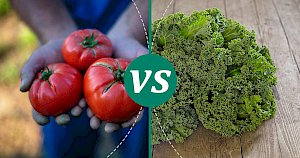Kale vs Tomato: Nutrition & Calories Compare


Kale vs Tomato
Nutrition Facts
Serving size:
change
5g10g15g20g30g40g50g60g80g100g120g140g160g180g200g220g250g300g350g400g450g500g600g700g800g900g1000g
1oz2oz3oz4oz5oz6oz7oz8oz10oz12oz15oz20oz25oz30oz35oz40oz50oz
Amount Per Serving:
Serving size:
change
5g10g15g20g30g40g50g60g80g100g120g140g160g180g200g220g250g300g350g400g450g500g600g700g800g900g1000g
1oz2oz3oz4oz5oz6oz7oz8oz10oz12oz15oz20oz25oz30oz35oz40oz50oz
Amount Per Serving:
Kale vs Tomato 100g Compare
| per 100g | Kale | Tomato |
|---|---|---|
| Calories | 49 | 18 |
| Carbohydrates | 8.75 g | 3.9 g |
| Fat | 0.93 g | 0.2 g |
| Dietary fiber | 3.6 g | 1.2 g |
| Protein | 4.28 g | 0.9 g |
| Calcium | 150 mg | 10 mg |
| Iron | 1.47 mg | 0.3 mg |
| Magnessium | 47 mg | 11 mg |
| Phosphorus | 92 mg | 24 mg |
| Potassium | 491 mg | 237 mg |
| Sodium | 38 mg | 5 mg |
| Zink | 0.56 mg | 0.17 mg |
| Vitaminium A | 9990 µg | 833 µg |
| Vitaminium B1 (Thiamine) | 0.11 mg | 0.037 mg |
| Vitaminium B3 (Niacin) | 1 mg | 0.594 mg |
| Vitaminium B6 | 0.271 mg | 0.08 mg |
| Vitaminium B9 (Folic acid) | 141 mg | 15 mg |
| Vitaminium C | 120 mg | 13 mg |
| Vitaminium K | 704.8 µg | 7.9 µg |
| Beta karoten | 5927 mg | 101 mg |
Kale and tomatoes, both hailed as superfoods, have their unique spots in the pantheon of healthful eating. Kale, a leafy green, is often celebrated for its nutrient density and versatility in cooking. On the other hand, the humble tomato, with its juicy sweetness, is a staple in cuisines around the world, beloved for both its flavor and nutritional benefits. But when it comes to a head-to-head comparison, how do kale and tomatoes stack up? Let’s delve into the interesting facts and figures to help you make informed choices about incorporating these foods into your diet.
A Closer Look at Kale
Kale, a member of the cabbage family, is not just a trendy leafy green. Its popularity has surged in recent years, thanks to its impressive nutritional profile. With a substantial amount of vitamins A, K, C, and minerals like calcium and iron, kale has been lauded for everything from its potential to support heart health to its role in bone health and immune function. Moreover, kale's versatility makes it a favorite among chefs and home cooks alike, easily incorporated into salads, smoothies, soups, and even chips.
Tomato: The Juicy Contender
Tomatoes, on the other hand, are technically fruits, though commonly used as vegetables in cooking. They are particularly noted for their high vitamin C content and the antioxidant lycopene, which has been linked to numerous health benefits, including reduced risk of heart disease and cancer. Tomatoes are incredibly versatile as well, making appearances in everything from fresh salads and salsas to sauces and soups.
Nutritional Breakdown: Kale vs. Tomato
When comparing the nutritional content of kale and tomatoes, it's clear that both offer valuable benefits. Here's a quick comparison based on a 100g serving:
- Calories: Kale has 49 calories per 100g, while tomatoes have just 18, making tomatoes a lower-calorie option.
- Carbohydrates and Fiber: Kale offers more carbs (8.75g) and fiber (3.6g) than tomatoes, which contain 3.9g of carbs and 1.2g of fiber. This makes kale a good choice for those looking to increase their fiber intake.
- Protein: Kale leads with 4.28g of protein compared to the 0.9g found in tomatoes.
- Vitamins and Minerals: Kale is a powerhouse of vitamins A and K, with significantly higher amounts than those found in tomatoes. It also boasts more calcium, iron, magnesium, and potassium. Tomatoes, however, are not to be underestimated, as they provide a good source of vitamin C and lycopene.
Both kale and tomatoes contain no cholesterol and are low in fat, making them excellent choices for heart-healthy diets.
Which One to Choose?
Ultimately, the choice between kale and tomatoes may come down to personal preference and nutritional needs. If you're looking for a low-calorie option rich in vitamin C and lycopene, tomatoes are an excellent choice. On the other hand, if you're seeking to increase your intake of fiber, protein, and vitamins A and K, kale might be the way to go.
However, there's no need to choose one over the other. Both kale and tomatoes can be part of a balanced and varied diet, contributing to overall health and well-being. Whether you're whipping up a kale salad or simmering a tomato sauce, incorporating these nutrient-dense foods into your meals can offer a host of benefits.
In conclusion, kale and tomatoes each bring their unique set of nutritional benefits to the table. By understanding their differences and similarities, you can make informed decisions about how to include them in your diet for maximum health benefits. Remember, a colorful plate is a healthy plate, so why not enjoy the best of both worlds?
Kale 100g
49kcalCalories source
- 58% CARBS.
- 28% PROTEIN
- 14% FAT
Tomato 100g
18kcalCalories source
- 74% CARBS
- 17% PROTEIN
- 9% FAT
Compares of kale
- Kale vs Artichoke
- Kale vs Arugula
- Kale vs Asparagus
- Kale vs Beetroot
- Kale vs Bitter Melon
- Kale vs Bok Choy
- see all compares of kale
Compares of tomato
Read also:
- Calories from Kale
- Calories of Kohlrabi
- Calories in Leek
- Lettuce calories per 100g
- Lima beans protein per 100g
- How many calories does lotus root have?
- Calories in a half of mustard greens leaves
- Calories in whole mustard greens leaves
- Calories for one, two or more mustard greens leaves
- Calories in handful of mustard greens leaves
- How much protein in okra?
Marcin Piotrowicz
calories-info.com creator
Healthy diet and healthy lifestyle promoter
Add comment